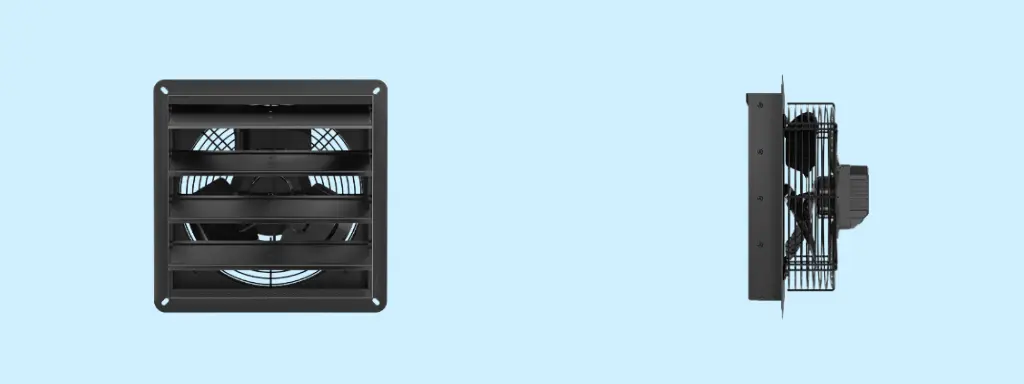Keeping your bathroom well-ventilated means nice air, but it also prevents moisture from building up and keeps mold and mildew away. Selecting a bathroom exhaust fan that’s the right size really matters, whether you’re building a house or replacing an old one.
This guide provides information on correctly choosing a bathroom exhaust fan size. By following it, from measurements to airflow ratings, you’ll pick the best fan for your bathroom.
Why Bathroom Fan Size Matters

Bathrooms are naturally damp places. Steam fills the bathroom every time you use the shower or bath. When the moisture stays in the room, it can cause your paint to peel, doors to swell, and mold to develop. A fan sized correctly removes damp air, so your walls, ceiling, and bathroom items stay in good shape.
A fan that doesn’t match your bathroom may cause excessive moisture or noise. That’s why you need to choose the right size.
Understanding CFM: The Key to Sizing

A bathroom exhaust fan’s size is shown as its CFM rating, or cubic feet per minute. This rating tells you how quickly a fan can remove air each minute. A higher CFM rating means the fan works more strongly.
Most people should go with at least 1 CFM for every square foot of floor in the bathroom. If your bathroom covers 50 square feet, your fan should be rated for at least 50 CFM.
But you should consider more than that as you start. Consider your ceiling height; extra airflow might be needed if your bathroom has a jetted tub or separate toilet space.
Instructions for Sizing Your Fan Step by Step
1. Measure the Room
At the start, check the length, width, and height measurements of your bathroom in feet.
Example:
- Length = 8 ft
- Width = 6 ft
- Height = 8 ft
The room’s volume measures 384 cubic feet.
This gives you the air that the fan will have to move around.
2. Calculate the Required CFM
The right way to size your fan is to divide the room’s volume by 7.5. Most people recommend exchanging air every 7.5 minutes, so this calculation uses that number.
384 ÷ 7.5 = 51.2 CFM
So, using a fan rated for no less than 50–60 CFM is recommended.
3. Adjust for Special Features
When your bathroom has these, it’s best to use a fan with a higher CFM:
One or more enclosed areas in your bathroom: Include an extra 50 CFM for every separate, enclosed part.
Jetted tub or spa bath: For the extra dampness, choose a fan that is 100 CFM higher.
Ceilings over 8 feet: Add 10–20% more CFM for every foot your ceiling is over 8 feet.
If your bathroom ceiling measures 10 feet, you must increase your CFM amount by 25%. Thus, a bathroom that needs a 50 CFM base would now need 62–65 CFM.
Recommended Fan Sizes Based on Bathroom Size
Here’s a quick reference chart for standard bathroom sizes:
Bathroom Size (sq. ft.) | Suggested CFM |
Up to 50 sq. ft | 50 CFM |
51–75 sq. ft | 70–80 CFM |
76–100 sq. ft | 90–110 CFM |
Over 100 sq. ft | Use multiple fans or a fan with higher CFM |
Other Things to Consider
Duct Size and Length
If your ducts aren’t right, a fan of the right size might still underperform. Rigid, smooth ducting is better than flexible tubes, so install the shortest and straightest duct possible. Airflow drops, and noise goes up when ducts are long or curved.
Noise Level (Sones Rating)
Sones are the unit used to describe fan noise. Lower sound ratings mean the fan will be quieter. Pick fans rated at 1.5 sones or less if you want your bathroom to stay quiet. You can select fans up to 2–3 seconds for guests or half bathrooms.
Energy Efficiency
Pick fans with the ENERGY STAR® label. Lower energy use doesn’t reduce their power, making them great for lowering your bill over time.
Installation Tip
Set the fan close to the wet area, usually above the shower or tub. A larger bathroom may benefit from another fan or a central system with more than one intake vent.
Where You Should Put the Fan to Work Best
Even when well-sized, a fan might not work well if it isn’t placed in the right spot. Make sure to put the exhaust fan near the highest source of moisture, often above the shower or bathtub. For bigger bathrooms, it’s a good idea to put the fan in the middle or install more fans for better air flow. Putting in another fan might be necessary when your bathroom is divided into separate rooms, such as a toilet room or dressing area. Putting the fan in the right spot will improve ventilation, dry surfaces faster, and clean the bathroom air.
How Does a Small Fan Affect Your Bathroom?
If your fan isn’t big enough for your bathroom, you may see:
- Mirrors not clearing up as quickly as you’d like after a shower
- Lingering smells
- Paint or wallpaper is beginning to come off
- Mold grows on the ceiling or in the corners.
They all mean your fan isn’t pulling enough air out of the room. A fan that’s the right size will solve these issues fast and safeguard your bathroom finishes.
Final Thoughts
Figuring out the right bathroom exhaust fan size isn’t hard, yet most people forget to do it. Taking time to measure your bathroom and work out the airflow lets you choose an efficient and quiet fan.
The correct fan size clears the air and reduces your home’s moisture and mold risk. If you’re unsure, slightly increasing your CFM works best, especially if your bathroom has multiple fixtures or high ceilings. Proper fan selection keeps your bathroom dry, clean, and healthy for the whole family.





